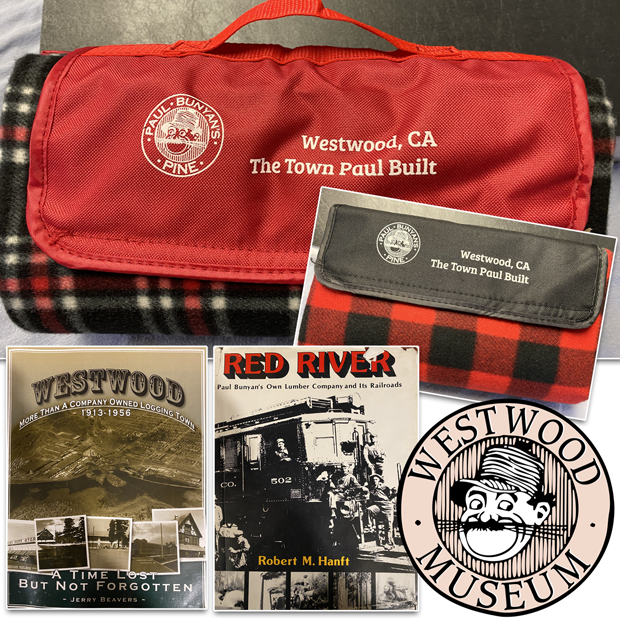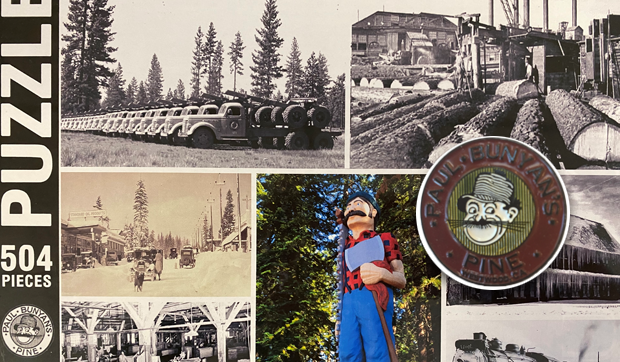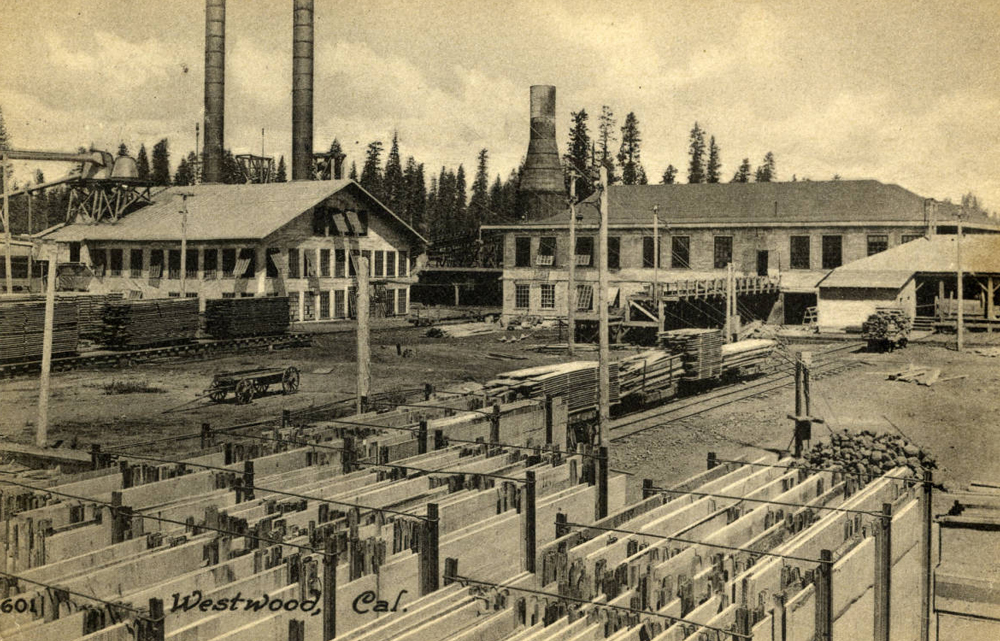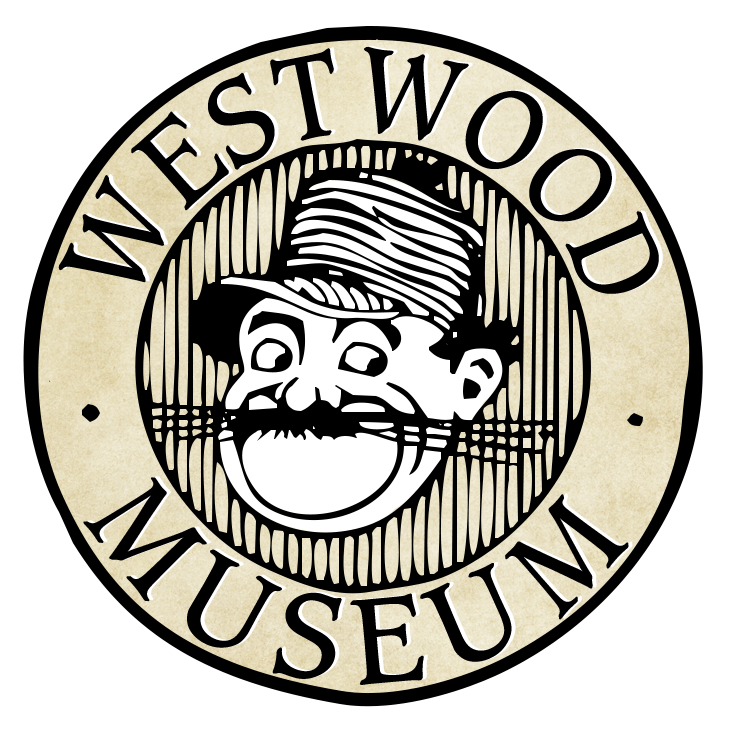
Come visit the Westwood Museum at 311 Ash Street, Wednesday through Saturday, from 11:00a.m. until 4:00p.m.
Stuck Inside? Looking for a Good Book? The Westwood Museum Has Neat Stuff!
Red River – Paul Bunyan’s Own Lumber Company and Its Railroads by Robert M. Hanft. This gorgeous book has more than 400 illustrations, maps and photos covering the history of The Red River Lumber Company, with special emphasis on the technical aspects of the lumber carrying trains that crisscrossed the Westwood area. Definitely a must-have book for any local railroad enthusiasts. $50
Westwood, More Than A Company Owned Logging Town 1913-1956 by Jerry Beavers. Author and historian Jerry Beavers’ excellent book covers parts of the Westwood story often overlooked in other books that focus only on the lumber industry. $30
Nifty Blankets The Westwood Museum has neat travel blankets with the museum logo on them. You can choose from blankets with red or black flaps. $20
A Westwood Puzzle While away the hours in coronavirus self-isolation with this unique Westwood jigsaw puzzle! More than 500 pieces assemble to create a frameable work of art featuring images from Westwood. $20
A Paul Bunyan Pin – A great souvenir from northern California’s favorite little lumber town featuring W. B. Laughead’s logo for “Paul Bunyan’s Pine.” $5
To order items you can email the Museum at westwoodmuseum@gmail.com. For information call 530 256-2233 and leave a message.
If you live in Westwood, you can call one of the numbers listed on the museum window and a museum staff member will come meet you with the items you’ve ordered. Locals can also email the museum their phone number set up an appointment to make their purchases.


As with many things in life, people often don’t realize what they have until they come close to losing it or it is gone.
The Red River Lumber Mill in Westwood was the largest operating mill in North America. It was founded in 1913 by the Walker Family. The town had a state-of-the-art hospital, a theater and opera house, the largest sawdust pile in the world and an indoor mall, said to be the first in the United States. The people who came here to live were a mix of people from the Midwest and immigrants, working side by side to earn a living and raise their families.
Although the mill had closed in this once-booming lumber community in the 1950’s, many reminders of the town’s past were still around in the early 1960s. The old theater was still showing movies; Charlie Monroe still opened the old skating rink so young and old could roller skate on weekends. Dr. Herman Levin had his practice in the old hospital although the hospital, itself, had closed. The trains still stopped at the old depot that sat by the tracks. Out where the mill had once been, many of the old mill buildings and sheds were still standing, a silent testimony to what had been a past rich in history that closely paralleled the growth and development of northern California and Lassen County.
Although there was talk of setting up a museum to preserve the past back when the town celebrated its 50th anniversary, little came of the efforts. As time went on, those who carried a wealth of information about the history of Westwood began to die and some of the landmarks from that time fell victim to old age or neglect.
Fires in the mill pond in the seventies destroyed the remaining structures from the mill days. Neglect and liability concerns were responsible for the old skating rink being torn down. In the early 1980s on a hot summer day, the old movie theater burned to the ground in a spectacular ball of flames dubbed the “pub fire”. A year earlier, the old Deerheart Lodge had burned down. The depot was moved to the old supper club to preserve it, but now the building is empty and the old hospital’s time is running out.
In the winter of 1987-88, Janice McGinnis and a few interested volunteers came together to form a committee to work toward establishing a permanent museum for Westwood. They met, at first, in their individual homes. The task was formidable but they had a clear goal in mind; they wanted to have a historical display in place when Westwood celebrated its 75th anniversary in 1988 and establish a permanent home for Westwood’s history and artifacts.
McGinnis and the other volunteers began contacting people that they knew had been saving treasures over the years. They also began doing interviewing, investigating funding sources and soliciting donations from others in the community. The process was slow. After much effort, the Westwood Museum came into existence. It is housed in the Westwood Community Services District Building on Ash Street in Westwood. As time has gone on, the museum has formalized its structure by gaining its non-profit status. A Board of Directors oversees the museum operation.
No building could ever contain the history, artifacts and stories from this community, but the Westwood Museum contains many original items from the town’s history. Logging and railroad memorabilia are well represented as are household items from the different eras. Special displays pay tribute to people who played a large role in the town over its span. Oral and written histories, collected by museum docents, flesh out the saga of Westwood. Binders feature major events such as the theater fire and the snow of 1952, the opening of the Westwood Mall and the organizations that provided the social network for the residents.
The Museum relies on donations, memberships and fundraising projects, such as the cookbook project, to generate operating funds.
A visit to the Westwood Museum is an opportunity to learn the story of this once mighty logging town and experience its history through the displays, memorabilia and visiting with the docents. The history of Westwood is not static, however, and new information and artifacts continue to find their way to the museum. You can take a tour with a docent or explore on your own, sit and read about events and people who shaped the community, listen to recordings or watch short videos on highlights of the town’s history.
